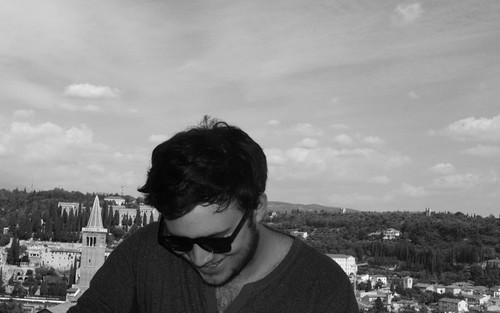Dawn Chorus // Marcus Coates

Marcus Coates’ audio-visual installation, Dawn Chorus, which ran at Brighton’s Fabrica gallery as part of Brighton festival this spring, is not what it first seems. Fabrica, an adapted church in Brighton’s city centre, is well-placed for drawing unsuspecting visitors into the gallery, and during Dawn Chorus the sound of birdsong was audible outside in the street, inviting in passers by with the prospect of a lush urban aviary. Once inside, the source of the avian chatter was revealed to be an amplified recording, but any disappointment gave way to beguilement as visitors were presented with an artwork comprising fourteen screens hung at various heights and angles within Fabrica’s high nave, each paired with the amplified song of a different bird. On each of the screens were sped-up recordings of people in everyday environments; in bed, in the bath, at an office desk, at the kitchen table, or sat behind the wheel in a car park, apparently mimicking the actions of the birds whose cries they have been juxtaposed with – with puffed chests, jutting heads, and pursed lips.
Coates placed human and bird alongside each other to underline the similarities, but what makes Dawn Chorus so fascinating is that we are not listening to birdsong at all. What we hear are actually human voices - the voices of the people in the footage, who are all amateur singers Coates plucked choirs around Bristol. With the help of scientist Peter McGregor and field recording specialist Geoff Sample, he spent several mornings recording the dawn chorus of birds in Northumberland, He then isolated the individual birds, and slowed the recording right down (roughly 20 times) to a range that a human voice could replicate. A particular bird was assigned to a particular singer according to their vocal range, and they were asked to reproduce what they heard. The audio was fed through an invisible earpiece, with the singers immediately reproducing the sounds that they heard, and then the recording of the singers sped up to the pitch of birdsong. The awareness of this production process brings a new perspective on the piece, and proffers the rather unique idea that humans and birds are simply two species living on different wavelengths, at different speeds.
Coates is a self-declared shaman, and makes artwork that attempts to make us aware of ourselves as animals, as part of the natural world and not apart from it. So many artists fall into the clichés of primitivism to express this idea, as if we are somehow more human, more animal, when foraging for berries in a loincloth than sat at a desk checking our emails. What Coates understands and conveys so effectively is that the everyday places we inhabit, our homes and workplaces, are our natural habitats. True, our social and cultural lives and our built environments do serve to detach us from ourselves as mortal, organic animals, but Coates rightly recognises that there is nothing unnatural about them. The point is not that, for example, our homes are like our nests - rather they are our nests.
Coates chose a selection of books to accompany the work in the gallery space, and the titles he chose are telling of the different interpretations that can be brought to bear on the piece. Alongside books about sound art were books about the history of music making, and Dawn Chorus encourages us to think too about why we make and listen to music. Is it biological? Is it cultural? Is there a reason at all? I’m reminded of a story that Laurie Anderson tells in her stage performance All The Animals about a concert she organised outside Sydney Opera House in 2010 where people were encouraged to bring their dogs. At the close of the concert the dogs, hundreds of them, started howling en masse and making a racket, in her words, “just because they can”.
Dawn Chorus ran at Fabrica, Brighton, from 3 April – 25 May.
- Published
- Jul 30, 2015
- Credits
- Words by Rob_Heath
